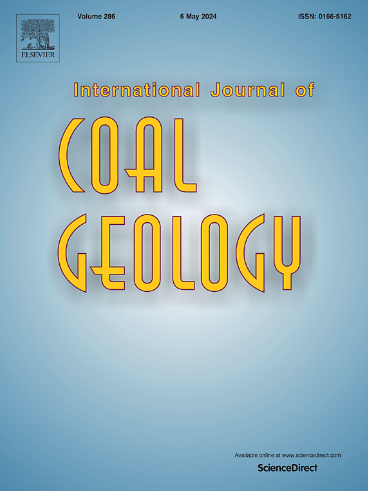构造演化过程对四川盆地及邻近地区五峰-龙马溪页岩埋藏、热熟化及成气历史的影响
IF 5.6
2区 工程技术
Q2 ENERGY & FUELS
引用次数: 0
摘要
五峰-龙马溪(WL)页岩广泛分布于中国西南的四川盆地及其邻近地区。盆地经历了多期复杂构造运动,对不同地区的埋藏、热熟化和成气历史的影响尚不十分清楚。在对盆地的剥蚀阶段、地层厚度和热历史进行详细研究的基础上,利用 PetroMod 软件模拟了不同地区 7 口井的埋藏和热成熟历史。由于 WL 页岩的成熟度较高,因此使用了低成熟度的志留纪波兰 Llandovery 页岩进行金管封闭系统热解实验,以获得评估甲烷生成历史的动力学参数。之所以选择波兰页岩,是因为其沉积年代、沉积环境和有机物类型与 WL 页岩相似。WL 页岩的埋藏历史可分为五个阶段:I. 早志留纪至中志留纪快速埋藏;II.加里东期隆起和剥蚀;III.二叠纪至三叠纪的持续埋藏和剥蚀;IV. 三叠纪晚期以来的持续埋藏;V. 白垩纪晚期至今的持续隆起和剥蚀。在第四阶段,所有油井中 WL 页岩的热成熟度随着埋藏深度的增加而增加。此外,由于基底热流相对较高,埋藏深度较深,第三阶段 JY1 井和 N201 井的计算反射率增量较高,导致当前的热成熟度高于其他井。二叠纪晚期-三叠纪早期和侏罗纪中期-白垩纪早期(或晚期)是 JY1 井和 N201 井产生甲烷的关键时期。相比之下,其他五口井只有一个甲烷生成阶段,主要由埋藏和热成熟过程决定。第五阶段的隆起时间和剥蚀量、目前的埋藏深度、断层和裂缝的发育、高比例的滞留以及上覆盖层岩体的密封能力是页岩气保存的关键因素。因此,本研究将有助于指导四川盆地未来的页岩气开发。本文章由计算机程序翻译,如有差异,请以英文原文为准。
Influence of tectonic evolution processes on burial, thermal maturation and gas generation histories of the Wufeng-Longmaxi shale in the Sichuan Basin and adjacent areas
The Wufeng-Longmaxi (WL) shale is widely distributed in the Sichuan Basin and adjacent areas in southwest China. The basin experienced multiple-stage complex tectonic movements, whose influences on burial, thermal maturation and gas generation histories in different areas are poorly understood. Based on a detailed study of the denudation stages, strata thickness, and thermal history of the basin, burial and thermal maturation histories of seven wells in different areas were modelled using PetroMod software. Due to the high maturity of the WL shale, a low-maturity Silurian Polish Llandovery shale was used for gold tube closed-system pyrolysis experiments to obtain kinetic parameters for evaluating methane generation history. The Polish shale was selected due to its depositional age, sedimentary environment and organic type, which are similar to the WL shale. The burial history of the WL shale can be divided into five stages: I. Early to Middle Silurian rapid burial; II. Caledonian uplift and denudation; III. Permian to Triassic sustained burial and denudation; IV. sustained burial since the Late Triassic; and V. Late Cretaceous to present sustained uplift and denudation. The thermal maturity of the WL shale in all wells increased with burial depth during stage IV. In addition, high calculated reflectance increments in wells JY1 and N201 during stage III occurred due to the relatively high basal heat flow and deep burial depth, resulting in higher current thermal maturities than in the other wells. The late Permian–Early Triassic and the Middle Jurassic–Early (or Late) Cretaceous were the key methane generation periods for wells JY1 and N201. In contrast, the other five wells had a single methane generation stage, mainly determined by burial and thermal maturation processes. The time of uplift and the amount of denudation during stage V, the current burial depth, the development of faults and fractures, high proportion of retention and the seal capacity of the overlying caprock are key factors for shale gas preservation. Hence, this study will help guide future shale gas development in the Sichuan Basin.
求助全文
通过发布文献求助,成功后即可免费获取论文全文。
去求助
来源期刊

International Journal of Coal Geology
工程技术-地球科学综合
CiteScore
11.00
自引率
14.30%
发文量
145
审稿时长
38 days
期刊介绍:
The International Journal of Coal Geology deals with fundamental and applied aspects of the geology and petrology of coal, oil/gas source rocks and shale gas resources. The journal aims to advance the exploration, exploitation and utilization of these resources, and to stimulate environmental awareness as well as advancement of engineering for effective resource management.
 求助内容:
求助内容: 应助结果提醒方式:
应助结果提醒方式:


